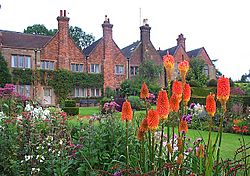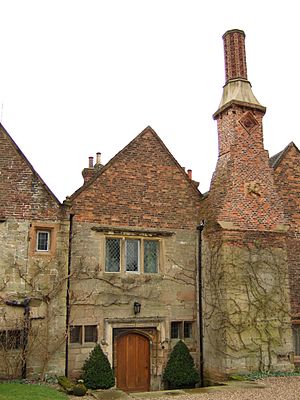Felley Priory facts for kids

The house built upon the former monastery
|
|
| Monastery information | |
|---|---|
| Other names | The Convent of St. Mary, Felley |
| Order | Augustinian |
| Established | 1156 |
| Disestablished | 1536 |
| Mother house | 1156–1260: Worksop Priory; then independent |
| Dedicated to | Saint Mary |
| People | |
| Founder(s) | Ralph Brito |
| Site | |
| Location | Nottinghamshire |
| Coordinates | 53°03′23″N 1°16′50″W / 53.056456°N 1.280452°W |
| Grid reference | SK4822151298 |
Felley Priory was once a special kind of religious house called a priory. It was built by a group of monks called Augustinians in 1156. You can find it in the village of Felley, in Nottinghamshire, England. The priory was closed down in 1536 as part of the Dissolution of the Monasteries. After it closed, a house was built on the same spot. This house is still there today.
Contents
History of Felley Priory
How Felley Priory Started
Felley Priory was started by a man named Ralph Brito in 1156. It was built where an older chapel used to be. A hermit, a person who lives alone for religious reasons, named Brother Robert lived there.
In 1151, Ralph Brito gave money to this hermitage. He placed it under the control of Worksop Priory. Worksop Priory stayed in charge when Felley Priory was built. This was even confirmed by a special letter from the Pope. This letter was called a papal bull. It was sent by Pope Alexander III in 1161. Worksop Priory remained in control until 1260. After that, Felley Priory became independent.
Donations and Growth
Ralph Brito and his son gave the church at Felley to the priory. Other people also gave gifts to the priory. These gifts included land and churches in different areas. For example, the church of Annesley was donated. The priory also received land in Nottinghamshire and Derbyshire.
Important leaders of the church, Pope Celestine III and Pope Gregory IX, also confirmed these gifts. This helped the priory grow.
Life at the Priory
Felley Priory was never very big. It was probably home to only about five or six canons. Canons were like monks who followed a specific set of rules. The priory church was likely quite simple. It probably had just a main hall and a small area for the altar.
In 1534, a record showed the priory's income was about £61. This was a good amount of money at the time.
The Priory Closes Down
In 1536, the priory was visited by two officials. They found that the priory had an income of about £40 a year. However, it also had almost as much debt.
The priory was closed down in 1536. This was part of King Henry VIII's plan to close many monasteries in England. This event is known as the Dissolution of the Monasteries. The last leader of the priory, Christopher Bolton, was given a yearly payment. This payment was later stopped when he became a rector, a type of priest, in another town.
What Remains of the Priory Today
Not much of the original priory building is left. After the priory closed, a house was built on its site. This house is also called Felley Priory. The main part of the house was built in the 1400s and 1500s. It is believed to use some of the old stone from the priory. The house has been changed and added to since the 1600s.
You can still see four old stone columns. They are thought to be from the priory church. These columns are now used as gateposts for the house. The old wall that surrounded the priory also still stands. You can also see the priory's old fishponds.
History After the Priory Closed
In 1539, the land of the former priory was given to William Bolles. However, he did not own it for long. Later, Queen Mary sold the land to Sir Anthony Strelley. His family owned Strelley, a nearby village.
After some time, the former priory land went back to the Crown. Then, King James I leased it to Anthony Millington. He made it his family home.
Gilbert Millington, Anthony's oldest son, was likely born at the house. Gilbert was an important member of Parliament. He was also a leader in Nottinghamshire when the Civil War began. This war was fought between King Charles I and Parliament. Because Gilbert supported Parliament, the King's supporters took his lands.
Gilbert Millington was one of the people who signed the paper to execute King Charles I. When the monarchy was brought back, he was sentenced to death. However, he was spared and spent the rest of his life in prison on the island of Jersey. He died there sometime between 1666 and 1676.



